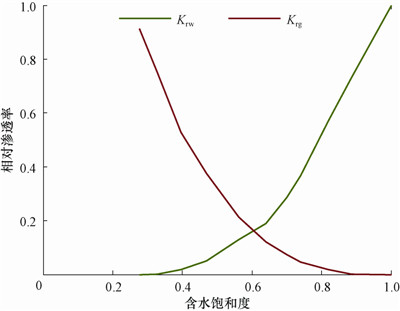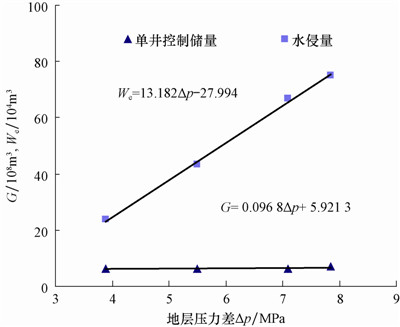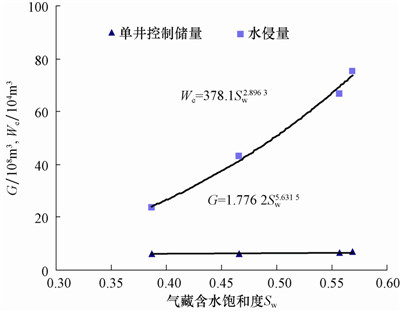2. 中国石油新疆油田分公司, 新疆克拉玛依 834000
2. PetroChina Xinjiang Oilfield Company, Karamay, Xinjiang, 834000, China
利用水驱气藏物质平衡方程计算气井的控制储量,一般须首先计算水侵量。常用的水侵量计算模型包括稳态模型、非稳态模型和拟稳态模型。非稳态模型又分为平面径向流模型、直线流模型和半球形流模型[1]。这些水侵量的计算方法比较繁琐和复杂,计算结果偏差较大,而且还必须在满足假设条件的情况下才能应用[2,3]。为了解决水侵量计算较为复杂的问题,不少学者利用最优化思想和图版拟合法对水驱气藏单井控制储量进行了计算[4,5,6,7,8,9,10,11,12,13,14]。但以上方法都需要利用计算机编程来实现,限制了其在现场的应用。为此,笔者提出用当前气藏含水饱和度与初始含水饱和度的差值来表示存水体积系数,并将其代入水驱气藏物质平衡方程中,推导出了计算单井控制储量和水侵量的公式。
1 当前气藏含水饱和度的确定当气井稳定生产时,生产水气比基本为一定值。这说明地层中气水两相的渗流情况稳定,水相、气相的平均相对渗透率稳定,根据相渗曲线确定出的含水饱和度即为当前气藏的含水饱和度。由于真正来自地层的自由水应该除去凝析水,而井底分流率定义为井底产出自由水量占井底流动条件总流体量的比例。因此,气井的井底分流率为[15]:

从渗流力学角度分析,在忽略毛管压力及重力影响时,分流率方程式可写为[16]:

当前气藏含水饱和度的确定步骤:1)根据实验室岩心分析所获得的气水相对渗透率曲线,绘制出Krg/Krw-Sw曲线;2)利用气井的日产水量、日产气量,计算出生产水气比Rwgp(凝析水气比Rwgc一般由现场试气作业获得,也可根据文献[17]中的方法计算得到),将Rwgp和Rwgc代入式(1)中可计算出井底分流率fw,再将其代入式(2)中便求得到气井的Krg/Krw;3)在Krg/Krw-Sw曲线中,查找气井Krg/Krw对应的含水饱和度Sw,由于Krg/Krw-Sw曲线是单调递减的,所以可以确定出当前气藏的含水饱和度Sw。
2 气藏水侵量和动态储量的确定常规的水驱气藏物质平衡方程未考虑凝析水的产出,认为气井产出水全部为地层水[1]。这样计算出的气藏存水体积偏小,气藏存水体积系数偏低。因此,考虑凝析水的产出,对常规水驱气藏的物质平衡方程进行改进。
气藏存水体积物质平衡方程为:

水驱气藏的物质平衡方程为:

令气藏的容积压缩系数为:

气藏的存水体积系数为:

将式(5)和式(6)代入式(4)得:

气藏的存水体积系数即气藏的存水体积占气藏容积的比例,也可以由当前气藏含水饱和度Sw与初始含水饱和度Swi的差值来表示,即:

联立式(7)和式(8)可得气藏的动态储量:

当气藏被单井控制时,或多生产井间无干扰时,单井控制的气藏范围可以认为是一个小型的气藏。此时,气井的控制储量就是这个小型气藏的动态储量,可用式(9)计算。
联立式(6)和式(8)可得气藏水侵量的物质平衡方程式:

某水驱气藏岩石的孔隙压缩系数Cp为1×10-4 MPa-1,地层水压缩系数Cw为4×10-4 MPa-1,初始含水饱和度Swi为0.289,束缚水饱和度Swc为0.277,原始地层条件下天然气的体积系数Bgi为0.003 8,地层水的体积系数Bw为1.03,试气作业确定凝析水气比Rwgr为0.108 m3/104m3。根据该气藏的相对渗透率曲线(见图 1)及3口井的压力测试数据、生产动态数据,利用不同方法计算了3口气井的控制储量和水侵量,结果见表 1。

|
| 图 1 气水的相对渗透率曲线 Fig. 1 Gas-water relative permeability curves |
| 井号 | 单井控制储量/108m3 | 水侵量/104m3 | |||
| 流动物质平衡法 | 动态拟合法 | 文中方法 | 胡俊坤法 | 文中方法 | |
| 1 | 6.73 | 6.94 | 6.86 | 74.46 | 75.07 |
| 2 | 2.75 | 3.13 | 2.94 | 35.22 | 37.69 |
| 3 | 9.05 | 8.27 | 8.49 | 92.09 | 87.63 |
由表 1可知:文中方法计算的单井控制储量与流动物质平衡法的相对误差为1.93%~6.90%,与动态拟合法的相对误差为1.15%~6.07%;文中方法计算出的水侵量与胡俊坤法[12]的相对误差为0.81%~7.01%。这说明文中方法与其他方法的计算精度相当。
该气藏某气井,至今总共进行了6次压力测试。根据文中方法及相关参数,计算出不同时刻的含水饱和度、单井控制储量及水侵量,结果见表 2。
| 测试时间 | p/MPa | Bg | Rwgp /(m3·10-4m-3) | Gp/108m3 | Wp /m3 | Sw | G/108m3 | We /104m3 |
| 2010-01-30 | 41.32 | 0.003 8 | 0 | |||||
| 2010-06-27 | 40.37 | 0.003 8 | 0.108 | 0.230 1 | 254 | |||
| 2011-07-17 | 37.44 | 0.004 0 | 0.174 | 0.977 9 | 1 151 | 0.386 6 | 6.37 | 23.64 |
| 2012-06-25 | 35.83 | 0.004 2 | 0.708 | 1.617 1 | 3 645 | 0.466 0 | 6.39 | 43.21 |
| 2013-06-26 | 34.22 | 0.004 3 | 2.683 | 2.299 7 | 14 914 | 0.557 1 | 6.42 | 66.70 |
| 2014-01-23 | 33.47 | 0.004 4 | 2.749 | 2.649 1 | 23 447 | 0.568 7 | 6.86 | 75.07 |
由表 2可知,随着气井生产时间的延长,地层压力下降,气藏的含水饱和度升高,气井的控制储量和水侵量增大。
根据表 2中的数据绘制该气井控制储量、水侵量与地层压力差和气藏含水饱和度的关系曲线,见图 2和图 3。由图 2、图 3可知:气井的控制储量与地层压力差、气藏含水饱和度Sw呈线性关系;水侵量与地层压力差呈线性关系、与气藏含水饱和度Sw呈指数关系。

|
| 图 2 单井控制储量和水侵量与地层压力差Δp的关系曲线 Fig. 2 Single well controlled reserves vs.water influx or formation pressure difference Δp |

|
| 图 3 单井控制储量和水侵量与气藏含水饱和度Sw的关系曲线 Fig. 3 Single well controlled reserves vs.water influx or water saturation Sw of gas reservoir |
1) 笔者提出的方法,不用考虑水体的形态和大小,仅利用生产数据和相对渗透率数据就可以求得气藏的动态储量和水侵量,实用性强,但由于求取气藏含水饱和度时要用稳定生产数据,因此该方法仅适应于生产时间较长(一般不少于半年)的气井。
2) 利用同一口气井不同时刻的数据,计算出不 同时刻的单井控制储量和水侵量,有利于跟踪和分析气井控制范围的变化。
3) 煤层气藏、页岩气藏中由于存在解吸过程,利用生产数据计算气井控制储量存在较大误差,需进一步根据其特殊的渗流机理提出新的计算方法。
| [1] |
李传亮.油藏工程原理[M].北京:石油工业出版社, 2005:121-168. Li Chuanliang.Fundamentals of reservoir engineering[M].Beijing:Petroleum Industry Press, 2005:121-168. |
| [2] |
张风东, 康毅力, 刘永良, 等.致密气藏开发过程中水侵量的最优化计算[J].油气地质与采收率, 2007, 14(6):85-87. Zhang Fengdong, Kang Yili, Liu Yongliang, et al.Optimized calculation of water influx in tight gas reservoir development [J].Petroleum Geology and Recovery Efficiency, 2007, 14(6):85-87. |
| [3] |
赵继勇, 胡建国, 凡哲元.无因次水侵量计算新方法[J].新疆石油地质, 2006, 27(2):225-228. Zhao Jiyong, Hu Jianguo, Fan Zheyuan.A new method for calculating dimensionless water influx rate[J].Xinjiang Petroleum Geology, 2006, 27(2):225-228. |
| [4] |
王怒涛, 唐刚, 任洪伟.水驱气藏水侵量及水体参数计算最优化方法[J].天然气工业, 2005, 25(5):75-77. Wang Nutao, Tang Gang, Ren Hongwei.Optimized calculating method of aquifer influx and parameters for water-drive gas reservoirs[J].Natural Gas Industry, 2005, 25(5):75-77. |
| [5] |
匡建超, 史乃光, 杨正文.综合总目标函数最优化方法计算水驱气藏储量与水侵量[J].天然气工业, 1993, 13(6):41-47, 6. Kuang Jianchao, Shi Naiguang, Yang Zhengwen.Comprehensive general objective function optimization method to calculate reserves and water influx of water drive gas reservoir[J].Natural Gas Industry, 1993, 13(6):41-47, 6. |
| [6] |
程时清, 杨秀祥, 谢林峰, 等.物质平衡法分区计算定容气藏动储量和压力[J].石油钻探技术, 2007, 35(3):66-68. Cheng Shiqing, Yang Xiuxiang, Xie Linfeng, et al.Multi-region calculation of dynamic reserve and pressure of constant volume reservoirs using material balance[J].Petroleum Drilling Techniques, 2007, 35(3):66-68. |
| [7] |
杨琨, 王怒涛, 张建民.水驱气藏水侵量及水体参数计算方法研究[J].大庆石油地质与开发, 2005, 24(5):48-50. Yang Kun, Wang Nutao, Zhang Jianmin.Research on calculation methods of water influx and water body parameters in water drive gas reservoir[J].Petroleum Geology & Oilfield Development in Daqing, 2005, 24(5):48-50. |
| [8] | Leung W F.A fast convolution method for implementing single-porosity finite/infinite aquifer models for water-influx calculations[R].SPE 122276, 1986. |
| [9] |
熊伟, 朱志强, 高树生, 等.考虑封闭气的水驱气藏物质平衡方程[J].石油钻探技术, 2012, 40(2):93-97. Xiong Wei, Zhu Zhiqiang, Gao Shusheng, et al.Material balance equation of waterflooding gas reservoir considering trapped gas[J].Petroleum Drilling Techniques, 2012, 40(2):93-97. |
| [10] |
冯景林.基于Havlena-Odeh法求取水驱气藏单井控制动态储量的简便算法[J].中国海上油气, 2006, 18(4):255-257. Feng Jinglin.A simple method to calculate single well controlled reserves of water drive gas reservoir based on Havlena-Odeh method[J].China Offshore Oil and Gas, 2006, 18(4):255-257. |
| [11] |
王富平, 黄全华, 王乐旭, 等.渗透率对低渗气藏单井控制储量的影响[J].断块油气田, 2008, 15(1):45-47. Wang Fuping, Huang Quanghua, Wang Lexu, et al.Influence of permeability on single well controlling reserves in low permeability gas reservoirs[J].Fault-Block Oil & Gas Field, 2008, 15(1):45-47. |
| [12] |
胡俊坤, 李晓平, 张健涛, 等.计算水驱气藏动态储量和水侵量的简易新方法[J].天然气地球科学, 2012, 23(6):1175-1178. Hu Junkun, Li Xiaoping, Zhang Jiantao, et al.A new convenient method for calculating dynamic reserves and water influx in water driving gas reservoir[J].Natural Gas Geoscience, 2012, 23(6):1175-1178. |
| [13] |
胡俊坤, 李晓平, 敬伟, 等.确定水驱气藏动态储量及水侵量新方法[J].新疆石油地质, 2012, 33(6):720-722. Hu Junkun, Li Xiaoping, Jing Wei, et al.A new method for determining dynamic reserves and water influx in water drive gas reservoir[J].Xinjiang Petroleum Geology, 2012, 33(6):720-722. |
| [14] |
刘斐, 陆正元, 王庆魁.隔气式有水气藏被分隔储集空间的储量计算[J].石油钻探技术, 2007, 35(3):69-71. Liu Fei, Lu Zhengyuan, Wang Qingkui.Reserve calculation of compartment reservoirs[J].Petroleum Drilling Techniques, 2007, 35(3):69-71. |
| [15] |
刘鹏超, 唐海, 吕渐江, 等.生产水气比对气井产能影响规律研究[J].特种油气藏, 2011, 18(5):100-102, 140. Liu Pengchao, Tang Hai, Lv Jianjiang, et al.Study on the impact of producing WGR on gas well productivity[J].Special Oil & Gas Reservoirs, 2011, 18(5):100-102, 140. |
| [16] |
翟云芳.渗流力学[M].北京:石油工业出版社, 1999:88-89. Zhai Yunfang.Fluid mechanics in porous medium[M].Beijing:Petroleum Industry Press, 1999:88-89. |
| [17] |
李士伦.天然气工程[M].北京:石油工业出版社, 2008:44-46. Li Shilun.Gas engineering[M].Beijing:Petroleum Industry Press, 2008:44-46. |


